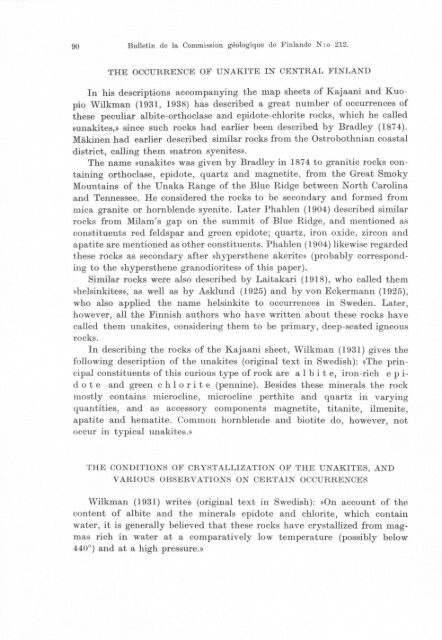COMMISSION GEOLOGIOUE - Arkisto.gsf.fi
COMMISSION GEOLOGIOUE - Arkisto.gsf.fi
COMMISSION GEOLOGIOUE - Arkisto.gsf.fi
Create successful ePaper yourself
Turn your PDF publications into a flip-book with our unique Google optimized e-Paper software.
90 Bulletin de la Co=ission geologjque de Finlande N: 0 212.<br />
THE OCCURRENCE OF UNAKITE IN CENTRAL FINLAND<br />
In his descriptions accompanying the map sheets of Kajaani and Kuopio<br />
Wilkman (1931, 1938) has described a great number of occurrences of<br />
these peculiar albite-orthoclase and epidote-chlorite rocks, which he called<br />
>)Unakites,>) since such rocks had earlier been described by Bradley (1874).<br />
Mäkinen had earlier described similar rocks from the Ostrobothnian coastal<br />
district, calling them »natron syenites».<br />
The name >)Unakite>) was given by Bradley in 1874 to granitic rocks containing<br />
orthoclase, epidote, quartz and magnetite, from the Great Smoky<br />
Mountains of the Unaka Range of the Blue Ridge between North Carolina<br />
and Tennessee. He considered the rocks to be secondary and formed from<br />
mica granite or hornblende syenite. Later Phahlen (1904) described similar<br />
rocks from Milam's gap on the summit of Blue Ridge, and mentioned as<br />
constituents red feldspar and green epidote; quartz, iron oxide, zircon and<br />
apatite are mentioned as other constituents. Phahlen (1904) likewise regarded<br />
these rocks as secondary after »hypersthene akerite» (probably corresponding<br />
to the »hypersthene granodiorites» of this paper).<br />
Similar rocks were also described by Laitakari (1918), who called them<br />
»helsinkites», as weIl as by Asklund (1925) and by von Eckermann (1925),<br />
who also applied the name helsinkite to occurrences in Sweden. Later,<br />
however, all the Finnish authors who have written about these rocks have<br />
called them unakites, considering them to be primary, deep-seated igneous<br />
Tocks.<br />
In describing the rocks of the Kajaani sheet, Wilkman(1931) gives the<br />
following description of the unakites (original text in Swedish): »The principal<br />
constituents of this curious type of rock are alb i t e, iron-rich e p i<br />
d 0 t e and green chlor i t e (pennine). Besides these minerals the rock<br />
mostly contains microcline, microcline perthite and quartz in varying<br />
quantities, and as accessory components magnetite, titanite, ilmenite,<br />
apatite and hematite. Common hornblende and biotite do, however, not<br />
occur in typical unakites.»<br />
THE CONDITIONS OF CRYSTALLIZATION OF THE UNAKITES, AND<br />
VARIOUS OBSERVATIONS ON CERTAIN OCCURRENCES<br />
Wilkman (1931) writes (original text in Swedish): »On account of the<br />
content of albite and the minerals epidote and chlorite, which contain<br />
water, it is generally believed that these rocks have crystallized from magmas<br />
rich in water at a comparatively low temperature (possibly below<br />
440°) and at a high pressure.»
















